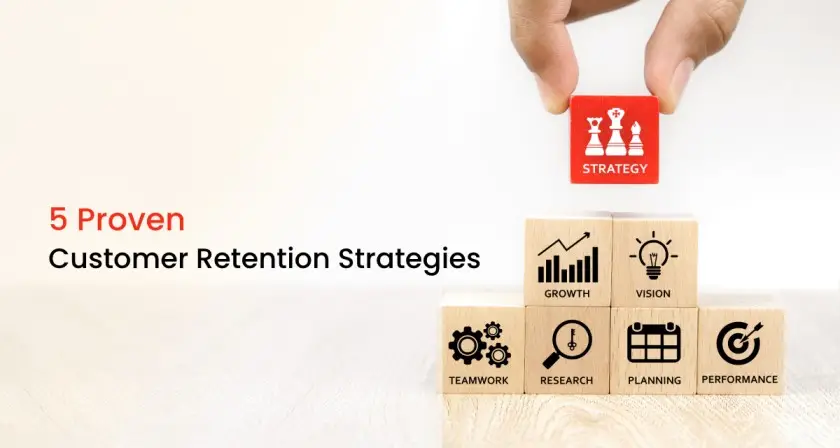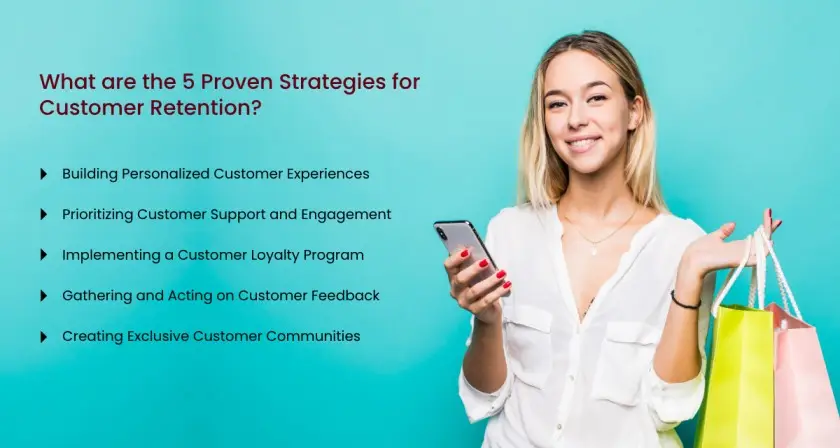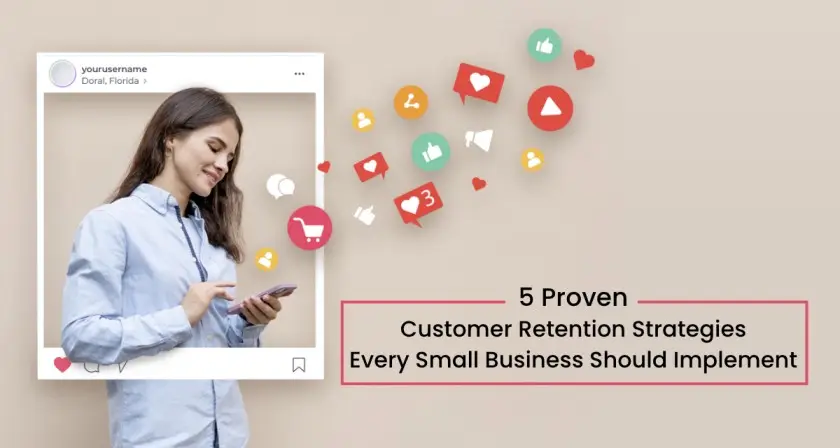In the business world, where innovation and shifting trends go hand in hand, one truth remains constant: customer retention is crucial to success. A loyal customer base that brings in revenue and spreads positive word-of-mouth about your brand is crucial for brands to survive in the current competitive landscape.
To achieve sustainable growth, small businesses must keep up with customer retention trends and adopt effective customer retention strategies that build trust, deliver value, and foster long-term relationships with their clientele.
This comprehensive guide will explore five proven customer retention strategies backed by research and real-world success stories.
Understanding the Importance of Customer Retention
1. Unlocking the Potential of Repeat Customers
Repeat customers are the backbone of a thriving business. Their decision to return for additional purchases speaks volumes about the quality of your offerings and the positive experiences they’ve had. Research indicates that acquiring a new customer costs up to five times more than retaining an existing one.
Building a robust foundation of customer loyalty is essential for any business and especially crucial for a small business’s growth. Small businesses heavily rely on word-of-mouth and positive customer reviews in the context of limited resources and marketing budgets. Loyal customers play a pivotal role in this aspect.
When customers are loyal to your brand, they become your brand advocates. Their recommendations and endorsements carry substantial influence, acting as trusted referrals that can significantly expand your customer base. This is a cost-effective way for small businesses to reach new audiences and grow organically.
Moreover, loyal customers tend to spend more with each subsequent purchase. For a small business, this translates into consistent and predictable revenue streams. It’s akin to having a group of committed patrons who provide ongoing business and serve as a financial backbone, enabling you to reinvest in your growth and expansion efforts. In essence, customer retention strategies are the lifeblood of small businesses, nurturing their development and helping them thrive in competitive markets.
2. Harnessing the Force of Customer Loyalty
A loyal customer base is among a business’s most valuable assets. These customers are not only repeat buyers, but they also provide valuable feedback that can help drive business growth. They are forgiving when mistakes are made, and instead of leaving negative reviews, they often communicate with the business to help resolve issues.
This kind of feedback is invaluable, as it allows small businesses to make improvements and adjustments to their products or services that can help them better meet the needs of their customers.
3. The Ripple Effect of Loyalty
Customer loyalty significantly impacts your brand’s identity. It goes beyond repeat business and creates a deep emotional connection between your customers and your brand. Loyal customers not only make purchases, but they also become advocates and champions of your business.
This advocacy has a profound effect on your brand’s reputation. Loyal customers willingly share their positive experiences with friends, family, and colleagues, effectively becoming brand ambassadors. These authentic endorsements carry significant weight with potential customers, often more than traditional advertising. This organic, word-of-mouth referral network is a testament to the transformative power of customer loyalty as a catalyst for growth and brand development.
What are the 5 Proven Strategies for Customer Retention?

1. Building Personalized Customer Experiences
Providing personalized customer experiences means tailoring your products, services, and interactions to match your customers’ individual preferences and needs. When customers feel understood and valued, they are more likely to remain loyal to your brand. By showing that you know your customers and are dedicated to meeting their specific requirements, you enhance their overall satisfaction and increase the likelihood of repeat business.
How to Personalize Customer Experiences
- Utilizing customer data: Implement data-driven strategies to gain insights into customer preferences, behavior, and pain points. Brands can use surveys and feedback forms to collect valuable 0 party data. Simultaneously, leveraging customer relationship management (CRM) software allows tracking interactions, collecting first-party data, and building comprehensive customer profiles.
- A study by Accenture revealed that 91% of customers are more likely to shop with brands that recognize, remember, and provide relevant offers and recommendations.
- Tailoring marketing campaigns: Craft personalized marketing messages and offers based on customer data. Use segmentation to target specific customer groups, delivering relevant content that resonates with their needs and interests.
- According to Epsilon, 80% of consumers are likelier to do business with a company that offers personalized experiences.
- Offering personalized product recommendations: Implement recommendation engines that suggest products based on previous purchases or browsing behavior, increasing the likelihood of upselling and cross-selling opportunities. Amazon’s recommendation engine is estimated to be responsible for 35% of its revenue, showcasing the power of personalized product recommendations.
2. Prioritizing Customer Support and Engagement
Exceptional customer support is a cornerstone of retaining customers. When customers encounter issues, they expect swift and practical solutions. By offering responsive and helpful support through various channels, you demonstrate your commitment to their satisfaction. Consistently positive interactions with your support team can turn a frustrated customer into a loyal advocate.
Furthermore, effective customer relationship management (CRM) ensures that you understand each customer’s history, preferences, and interactions comprehensively, enabling more personalized and informed customer engagements.
How to Prioritize Customer Support and Engagement
- Providing seamless multi-channel support: Offer various communication channels, including phone, email, live chat, and social media, to cater to diverse customer preferences and ensure quick responses to queries and complaints.
- Research by Zendesk found that 72% of customers will share a positive experience with six or more people, highlighting the impact of excellent customer support on word-of-mouth marketing.
- Training customer support representatives: Equip your support team with comprehensive product knowledge, empathy, and problem-solving skills to deliver exceptional customer experiences.
- Proactive engagement: Monitor social media channels and online forums to address customer feedback promptly. Engage with customers by responding to comments and messages, showcasing your commitment to meeting their needs.
- Starbucks’ My Starbucks Idea platform encourages customers to share ideas and suggestions, fostering engagement and collaboration.
3. Implementing a Customer Loyalty Program
A customer loyalty program rewards customers for their repeat business. It can include discounts, special offers, exclusive product access, or points redeemed for rewards. Such programs incentivize customers to continue purchasing from your brand, as they feel that their loyalty is recognized and rewarded. This also encourages them to spend more to unlock more significant benefits, contributing to increased customer lifetime value.
How to Launch a Successful Loyalty Program
- Designing an enticing loyalty program: Develop a well-structured loyalty program that aligns with your customer’s preferences and purchasing behavior. Offer rewards, such as discounts, exclusive product access, or early-bird event invitations.
- Engaging customers with tiered rewards: Create a tiered loyalty program based on customer spending or engagement levels, motivating customers to progress and unlock more enticing benefits.
- For example, Airlines like Delta and American Airlines offer elite status tiers that provide customers with additional perks such as priority boarding and complimentary upgrades.
- Tracking and measuring loyalty program performance: Utilize analytics to assess the effectiveness of your loyalty program, identifying patterns and opportunities for improvement.
4. Gathering and Acting on Customer Feedback
Listening to your customers is crucial for understanding their needs, concerns, and preferences. Collecting feedback through surveys, reviews, and direct interactions helps you identify areas for improvement and innovation. When customers see that their opinions are valued and result in tangible changes, they develop a sense of ownership of your brand. This active engagement demonstrates that you are committed to enhancing their experience, ultimately boosting their loyalty.
How Brands Can Gather and Leverage Customer Feedback:
- Utilizing surveys and feedback forms: Regularly seek customer feedback through surveys and feedback forms to gain insights into their satisfaction levels and identify areas for improvement.
- A study by ReviewTrackers found that 52% of customers expect to hear back from brands regarding their feedback within seven days. If you implement this in your retention strategy, there can be a significant chance of growth!
- Leveraging Net Promoter Score (NPS) surveys: Measure customer loyalty and brand advocacy using NPS surveys to understand how likely customers are to recommend your business to others. Companies with high NPS scores tend to have a higher percentage of customer retention and organic growth.
- Responding to customer feedback: Show customers their opinions matter by acknowledging feedback and implementing necessary changes. Publicly addressing negative reviews demonstrates your commitment to customer satisfaction.
5. Creating Exclusive Customer Communities
Building a sense of belonging and community around your brand can strengthen customer loyalty. Creating exclusive forums, social media groups, or events provides a space where customers can connect with your brand. This fosters a deeper relationship beyond transactions.
Exclusive communities also offer opportunities for customers to share experiences, offer advice, and feel part of something larger, thus reinforcing their loyalty.
How Brands Can Build Communities of Loyal Customers:
- Making a sense of belonging: Establish online communities on social media, forums, or dedicated websites to create a space where customers can interact, share experiences, and engage with your brand.
- Harley-Davidson’s HOG (Harley Owners Group) community has over a million members worldwide, fostering a sense of camaraderie among motorcycle enthusiasts.
- Providing exclusive content and events: Offer valuable content, such as educational resources, sneak peeks of upcoming products, and virtual events, exclusively to community members, fostering a sense of exclusivity and brand loyalty.
- Lululemon’s Sweat Collective program provides fitness instructors exclusive access to events and products, cultivating a loyal community of brand advocates.
- Nurturing community engagement: Appoint community managers to facilitate discussions, moderate content, and ensure a positive and supportive environment for all members.

Conclusion
Implementing customer retention strategies is not a one-time effort but an ongoing commitment to building lasting customer relationships. By understanding the significance of customer retention, delivering personalized experiences, prioritizing exceptional customer support, implementing a well-designed loyalty program, gathering and acting on customer feedback, and creating exclusive customer communities, small businesses can increase customer loyalty, drive sustainable growth, and establish a robust foundation for long-term success.
Remember that each business is unique, so experiment, iterate, and tailor these strategies to suit your specific audience and industry. Embrace the journey of nurturing loyal customers, and your small business will thrive in the competitive marketplace.
Key Takeaways & Actionable Steps
In the ever-evolving world of small businesses, cultivating customer retention is the keystone for enduring success. Loyal patrons not only enhance your revenue streams but also boost organic brand promotions, significantly reducing marketing expenses. The phenomenal success of brands like Starbucks and their loyalty programs underscores the power of retention strategies. To tap into these dividends:
- Delve deep into customer interactions and insights to craft tailored experiences and offers.
- Ensure consistent brand experience across all touchpoints, emphasizing simplicity and authenticity.
- Foster open channels of feedback and support, encompassing methods from traditional phone support to modern social media engagement.
- Establish enticing loyalty programs that offer tangible rewards, encompassing everything from exclusive access to special discounts.
- Importantly, treat customer feedback as gold, always acknowledging and iterating based on it.
By ingraining these principles, small businesses can secure a loyal customer base, laying a robust foundation for consistent growth and resilience.
Increase Customer Retention Rate With Zinrelo!
Learn how our holistic loyalty platform can transform your business.


